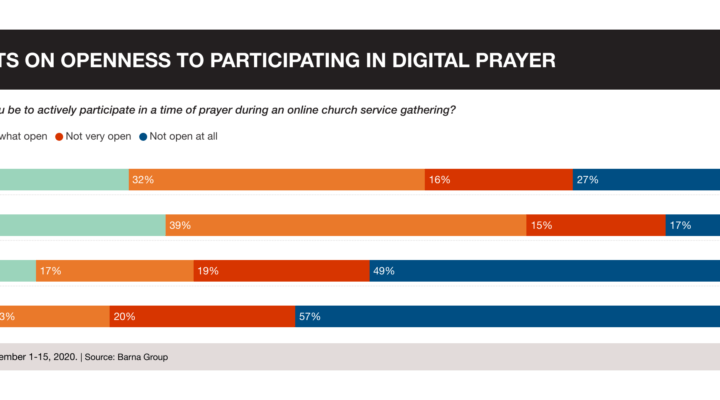New research into the impact of online church programming suggests that virtual prayer gatherings may boost participation and fellowship for Christians active or inactive in congregational life.
Online corporate prayer opportunities, when offered, have been found to be especially effective during the coronavirus outbreak and are expected to have influence moving forward, the Barna Group reported.
The research uncovered a greater willingness among respondents to participate in online gatherings when prayer is the major or sole focus. “Across the board, in-person corporate prayer is still more common than digital corporate prayer. But some people are more open to and present in online group prayer,” Barna said.
The research uncovered a greater willingness among respondents to participate in online gatherings when prayer is the major or sole focus.
And there are strong indications those participants may have a leavening effect on others.
“Data show these may be churchgoers who already attend or prioritize the kinds of church environments that are likely to be cultivating a digital prayer culture,” Barna reported. “These adaptable attendees could also be helpful in welcoming fellow congregants who find digital church options inaccessible or uninteresting.”
Opportunities to participate in virtual prayer gatherings, however, have been relatively limited, Barna explained.
“Many churches are new to hosting online services, let alone other digital or hybrid gatherings that emphasize group prayer. Most adults who have attended churches providing online services through the pandemic (60%) say this is the only digital activity through their church.”
Consequently, most churchgoers have not actually attended virtual gatherings intended mostly for prayer, the report added. “Overall, the majority of Christians does not typically participate in gatherings intended for group prayer (68% in-person, 72% digital) — not a huge surprise, considering the tendency to prefer solo and silent prayer.”
But preference isn’t the only factor researchers considered in the study, which also found that “digital and hybrid ministry approaches rarely reach beyond the standard service and sermon” and “where engagement with digital prayer or other aspects of COVID-era church life lag, we’re likely observing a lack of church options, a lack of congregant participation or both.”
Barna uncovered strong interest in virtual prayer services, nonetheless. When asked how open they are “to actively participating in a time of prayer during an online church service gathering,” nearly 70% said they were either somewhat or very open to the idea. Among all U.S. adults, 57% said they are open to such participation.
When non-Christians were asked to rate their openness to online prayer events, 32% were either very or somewhat open to the proposition, as were 23% of Americans with no religious affiliation.
“It is striking that those who practice their faith less often, like non-practicing Christians, still will, on occasion, attend prayer groups or gatherings,” Barna said.
“It is striking that those who practice their faith less often, like non-practicing Christians, still will, on occasion, attend prayer groups or gatherings.”
The study reported that about one in five non-practicing Christians prays digitally with either a small group or a large group at least once a month. “One in four (24%) goes so far as to say that no barrier would keep them from considering participating in a digital group prayer experience.”
Strong interest and ongoing practice also were found among younger generations, non-white Christians and digitally savvy churchgoers, the research found.
Approximately two in five Millennial and Generation Z Christians report at least monthly participation in virtual group prayer activities. About 44% of non-white Christians are very open to the idea, and half say they have attended a digital prayer session in the past year.
“Seven in 10 churched adults with high digital openness report praying in online groups with some frequency, and many do so at least weekly (47% in small groups, 32% in large groups),” the report states.
Barna said the study suggests that churches can appeal to young Christians, non-white Christians and others who are tech-friendly with dedicated online prayer groups.
“In this way, church leaders can begin digital prayer gatherings with a solid foundation of attendees who will both engage in these times of corporate prayer while also extending invitations to churchgoers who are less likely to find their way into this setting.”
Related articles:
5 things I learned from visiting 50 online churches during the pandemic | Opinion by Laura Beth Buchleiter
Hybrid church is probably here to stay, but some things don’t translate well to digital
Pandemic opens the door to a far-flung notion of church membership


